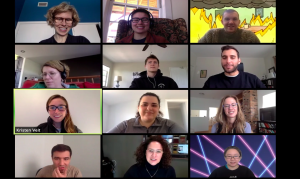Public meetings are synonymous with community engagement. However, no one is hosting in-person meetings right now. We’re left to choose between postponing them or taking them online. But take our advice as a team who has hosted many webinars and online meetings: you can’t conduct an online meeting in the same way you would if you were hosting it in person.
If you’re planning on having your next community meeting online, here are some tips for successful engagement. We recommend using Zoom because it has the easiest user experience for participants. That being said, the features we describe below exist in most other platforms, too.
Here are our tips for running a successful virtual meeting:

- Plan a rehearsal. Don’t let the actual meeting be the first time your team runs through the setup. Schedule time with other presenters prior to the event to review the platform, discuss roles, delegate responsibilities, and finalize the agenda.
- Have a team member join as a participant. Whether you’re sharing slides or speaking face-to-face with your audience, what displays on your screen is important for engaging the audience. Having someone from your team joining as a participant allows them to provide feedback and make adjustments as necessary for both audio and visual components of the meeting.
- Mute participants. Background noise is a huge distraction and makes it difficult for everyone to listen and follow along. Many individuals might not know how to mute themselves, but the host can mute all.
- Don’t assume people know how to use the platform. At the beginning of the meeting, dedicate a few minutes to explaining how the meeting will be conducted and how you expect participants to engage.
- Disable unnecessary features. This includes file transfer, screen sharing for non-hosts, and the “Join Before Host” feature.
- Record the meeting as a video. Zoom allows you to record your meeting so you can share with community members who were unable to attend. Explore these settings the day before your meeting so you are comfortable with this feature on meeting day.
- Enable “Waiting Room.” This feature will prevent attendees from joining the meeting before you (the host) are present or before you’re ready to start the meeting. By creating a virtual meeting room, attendees can be added to the meeting at the actual start time. This feature is also convenient in the case that you have to remove someone from the meeting and do not want them to be able to reenter.
- Gather an attendee list. After the meeting is over, you (as the host) can generate an attendee list. Just click: Zoom Account Management > Reports section.
We also encourage you to explore other ways to engage the community. Keep in mind that public meetings, even when virtual, aren’t totally inclusive. Attendees at public meetings tend to be older, white men, especially homeowners – and they’re likely to dominate the conversation. Those in attendance tend to not be representative of the community as a whole, leaving the voices of so many in the community unheard. Taking the meetings online presents us with a unique opportunity to make the engagement process more inclusive, but it’s still not perfect.
That being said, here are our top four tips for any public meeting – virtual or in-person:
- Broaden your outreach. Instead of operating from a place of fear and worry, activating silent supporters will allow you to curate data around real public sentiment about the project. Welcoming public attention allows your team to fight misconceptions with facts to garner support for your project.
- Tackle discriminatory remarks. As the meeting chair, set rules and address inappropriate comments as they are made. By anticipating what misconceptions community members might hold about a certain project or type of development, you can be prepared with facts and figures to dispel any misconceptions. The inclusion of affordable housing in development proposals can sometimes stir up unfounded fears, but by being prepared with easy-to-understand information and explanations about what affordable housing really means, you can educate participants and dispel unfounded fears. If you opt to generate community engagement online, coUrbanize has strict community guidelines to keep the conversation focused and on track.
- Meet community members where they are. Share updates and information about your project where your audience already receives their information. Chances are, the town or community already has a neighborhood Facebook group that can be leveraged for communication. Channeling an update through a local elected representative or posting well-placed signs can both be effective ways to reach your silent supporters.
- Hold more than one meeting. Public meetings are just one piece of the community engagement puzzle, and utilizing multiple will help your outreach be more effective. Community members can get the facts about projects and have the opportunity to get their questions answered by you directly in a moderated forum. They can share input and ask questions online and through text messages, without having to attend an in-person meeting. By opening the door for communication with community members, you can constructively fight misconceptions with facts to ultimately garner support for your project.
Because it’s more important than ever, we’re here to help evolve your community outreach strategy to generate support for your projects by connecting with your community in a meaningful way. Check out our playbook for community engagement to learn more about the strategies we’ve seen work across 400+ projects.
– The coUrbanize Marketing Team


